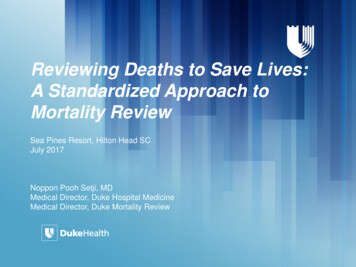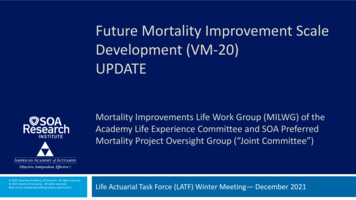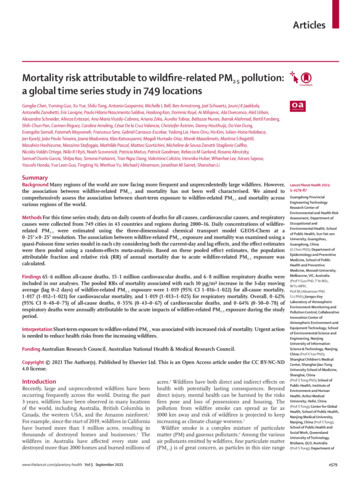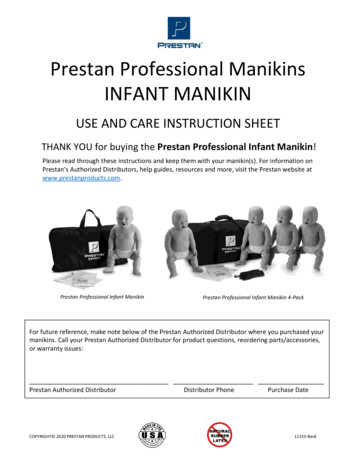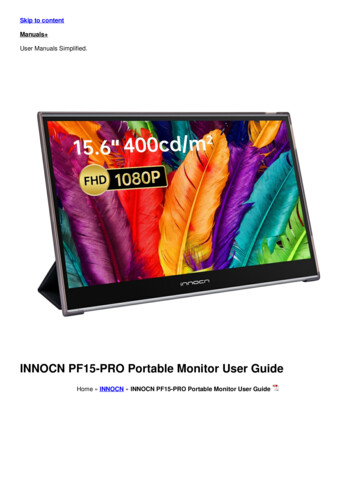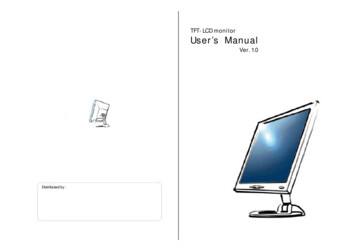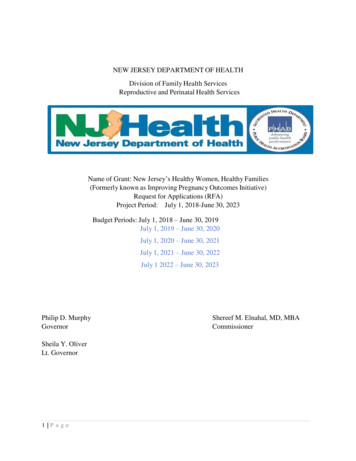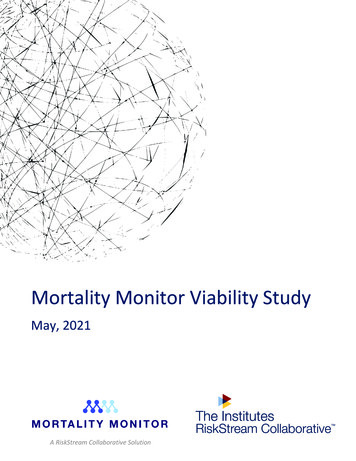
Transcription
Mortality Monitor Viability StudyMay, 2021A RiskStream Collaborative Solution
The RiskStream Collaborative’sMortality MonitorAn Overview and Viability StudyBy Patrick Schmid, PhD*Special Thanks to Sandy Hampel for the detailed background of the Mortality Monitor usecase, as well as leadership and assistance throughout this project.This report, The RiskStream Collaborative’s Morality Monitor – An Overview and Viability Study, is available from:The Institutes RiskStream Collaborative 720 Providence Road, Suite 100, Malvern, Pennsylvania, 19355-3402(610) ollaborative 2021, The Institutes RiskStream Collaborative. All rights reserved.
ContentsExecutive Summary.4IntroductionIntroduction . 7The Institutes RiskStream Collaborative. 8Life & Annuity Use Cases. 10Mortality MonitorMortality Monitor. 15Mortality Monitor Minimal Viable Product . 17Mortality Monitor Working Group . 19Viability Study and Analysis . 19Problem StatementProblem Statement.21Data Analyzed .Methodology .2325Results .27Data and MethodsResultsConclusionConclusion.36
Mortality Monitor Viability StudyExecutive SummaryIn the U.S., nearly as many life insurance policies are in force as people are in residence.Specifically, as of 2018, 267 million life insurance policies were in force1 among a populationof roughly 330 million.2In addition, Americans leverage a substantial number of retirement plans and annuities. Forexample, some 100 million Americans3 are now covered by defined contribution accounts,mostly 401(k) plans, and an estimated 30 million individual annuity contracts are in force.4Overall, a large percent of the population is involved in life insurance contracts (bothindividual and group) and other financial products (like annuities and retirement plans).Therefore, an individual who passes away, is likely listed in numerous databases that spanacross organizations.For example, John Doe may have an individual life insurance policy, a group life insurancepolicy and annuity, and a retirement account all with different carriers Today, the process ofnotifying carriers of a deceased policyholder’s death can be inconsistent across carriers andtake time for the beneficiary.The carrier first must learn that the policyholder died. Then it must collect and assemblethe pertinent information and documents from multiple sources, which means duplicationof data, high rework and potential for errors. Meanwhile, beneficiaries experience difficultygathering and completing all the documentation so that they can start the process ofnotification and eventually receive death benefits. The challenge is in the lack of a singlesource of truth for processing death benefits and claims.To fill this need, The Institutes RiskStream Collaborative has developed a MortalityMonitor application using blockchain technology. This application aims to mitigatedata-sharing challenges during the death claims process and help participants on theRiskStream Collaborative network identify potential deaths more quickly by incentivizingsecure, permissioned data sharing. This, in turn, can improve the beneficiary experiencewhile reducing time, cost, and risk to the carrier or organization.The corresponding study sought to test the viability of this Mortality Monitor concept witha confined scope and a small network of participants. Three carriers provided five years ofclaims data around two key questions: First, within the three datasets, were there deceasedpolicyholder matches? And second, if such matches existed, how much time elapsed between1 Statista, “Total Number of Life Insurance Policies in Force in the United States From 2008 to 2018”, -insurance-policies-in-force/2 Worldometer, “United States Population”, -population/3 CNBC, “America’s Retirement Accounts Are Growing, but Not Fast Enough,” June 12, 2019, t-accounts-are-growing-but-not-fast-enough.html4 Insured Retirement Institute (IRI), “IRI Retirement Fact Book 2020” (IRI, 2020)4
Mortality Monitor Viability Studythe first payment from the first carrier and the first payment from the last carrier? Thefindings were further inspected by company and type of product.The results show that about 4% of deceased policyholders of one of the carriers also hadpolicies (life or individual policies) or other financial instruments (annuities or retirementplans) with one of the two other carriers. This number is much larger than expected andwould undoubtedly grow if a larger network of organizations participated in a future study.The findings also show that when a policyholder has policies with more than one carrier,there is a median 55-day gap between the first and last carrier’s paid claim date. The averageis even larger.Nonetheless, both the average and median highlight the value and viability of a networkthat shares decedent profile information. Such a resource would undoubtedly lead to greaterefficiency and reduced beneficiary frustration during the death registration and claimsinitiation process.5
Introduction
Mortality Monitor Viability StudyIntroductionThe life and annuities (L&A) industry is changing. The pandemic and associated economicdownturn are expediting the need to incorporate and adopt technological change, asindustry players seek to maximize operational efficiency in a new world.5As the L&A industry moves further into the 2020s, it is faced with an increasingly fastmoving, innovative, and data-driven environment—with large-scale changes to traditionalindustry products, processes, distribution, and employment sure to follow. New risks areemerging. New forms of data and analytics are changing the way the industry operates andanalyzes risk. New tools are helping to create innovative efficiencies.The industry is embracing a variety of new technologies, including blockchain andbroader distributed ledger technology (DLT), all at once.Meanwhile, today’s economic climate presents many challenges for organizations withinthe L&A industry.In an extended period of weak income growth, volatile consumer prices, greater access toinformation, ever-evolving technology and increasing globalization, consumers demandmore from suppliers, including life and annuities organizations. Yet, investment yields andprofits have been constrained by low interest rates6, concerns about economic stability andassociated volatile regulatory scrutiny.Insurance-related organizations have increasingly begun focusing on cost minimization todrive profitability. Much of this focus has been on leveraging technology to lower the costsof shared recordkeeping, easing data retrieval for multiparty workflows, simplifying sharedbusiness processes, combating fraud, and finding an efficient path within a stringentregulatory environment.As all of these factors play out and technological change flourishes within the risk management and insurance industry, blockchain and DLT will play a pivotal role. Most new technologies, including the internet of things, artificial intelligence (AI), and machine learning,provide a means to capture and analyze data. Blockchain technology provides somethingdifferent: a secure and permissioned way for entities to share data without the need for anintermediary, allowing for more seamless shared business processes.Until recently, competitors within the insurance industry were wary of sharing data becausethe benefits of setting up centralized intermediaries outweighed the security risks and costsonly in certain situations. That calculation changed with the birth of blockchain technology.5 Deloitte, “Covid-19 impact to life insurance and annuity companies”, annuity-considerations.pdf6 National Association of Insurance Commissioners (NAIC) Low Interest Rates, 9/3/2020,https://content.naic.org/cipr topics/topic low interest rates.htm7
Mortality Monitor Viability StudyAcross the financial services industry, many are looking at blockchain and broader DLTtechnology as ways to streamline the flow and verification of data, lower operating costs,improve processes, and reduce the need for intermediation. For example, they may provide: Privacy with permissioned data sharing Lower administrative costs Trust and auditability Increased automation Reduced fraudIn this report, The Institutes RiskStream Collaborative demonstrates the potential forDLT technology within the L&A market and focuses on the benefits for a lead use case, theMortality Monitor.By providing an overview of blockchain and DLT technology, an explanation of the RiskStream Collaborative, a high-level analysis on blockchain use cases and their stackablebenefits, an overview of Mortality Monitor, an explanation of the approach for the viabilitystudy, and the results of our analysis, this report proves the viability of the MortalityMonitor use case, setting it on a path to production within the RiskStream Collaborativemembership.The Institutes RiskStream CollaborativeAt its core, the technology behind blockchain and DLT is network driven. While it provides a means to work on universal problems that plague the industry and add costs, it alsorequires a nonpartisan arbiter to test, learn about, and implement it.The Institutes RiskStream Collaborative emerged from The Institutes, a not-for-profit educational entity formed over 100 years ago out of The Wharton School.The Institutes educate more than 100,000 learners annually on risk management and insurance topics. Its Board of Directors include chief executive officers who represent a majorityof domestic property-casualty (P&C) insurance premium volume and whose organizationshave a sizable international presence.If a private permissioned blockchain requires a network, The Institutes already have anestablished network within the P&C insurance space. To establish that same arrangementin the L&A space, the RiskStream Collaborative teamed up with LIMRA, a research andprofessional development trade association for the financial services industry.The RiskStream Collaborative is a separate not-for-profit that has been working on blockchain and DLT applications for the last few years. Today, it operates as a consortium thatuses its network of member companies to develop industry-specific DLT applications forvaried use cases.8
Mortality Monitor Viability StudyWhile activity for the consortium began in P&C insurance, the L&A industry is quicklycatching up. RiskStream Collaborative members (carriers, distributors/brokers, and reinsurers) lead all areas of the consortium’s governance and activity. For example, members andleadership work to prioritize use cases and launch working groups. These groups, in turn,design use cases and then work with staff and solution providers to build out the associatedapplications.While all of RiskStream Collaborative’s efforts center around members, the consortium hasstarted creating a larger ecosystem (see Figure 1). Its goal is to position providers; not-forprofits; collaborators; and regulators and governments, or civics, to help consortium members devise solutions to shared business processes within the risk management and insurancespace.Figure 1RiskStream Collaborative Participant Categories & EcosystemProvidersa.b.c.d.e.f.ConsultantsSoftware for-Profitsa. Associationsb. Academiac. ConsortiaMembersa. Carriersb. Producersc. ReinsurersCollaboratorsa.b.c.d.Legal EntitiesBanksEnergy CompaniesOtherCivicsa. Regulatorsb. Governments9
Mortality Monitor Viability StudyLife & Annuity Use CasesBlockchain and DLT are poised to have widespread ramifications across the L&A sector’svalue chain, increasing market reach, removing redundancy, and cutting costs (Figure 2).Figure 2:Figure 2Potential L&A Use Cases (Non-Exhaustive)Products, Pricing &DistributionUnderwriting & RiskManagementPolicyholder Acquisition& ServicingFinance, Payments &AccountingRegulatory &Compliance1035 ExchangeCreation of Repository ofTruth for UnderwritersIn-Good Order ValidationMortality Monitor –Decedent Profile DataSharingCommission SchedulesLicensing,Appointment &EducationProduct Version andAssociated Rider DataHealth RecordsDocumentAdministration, Servicingand DeliveryFraud RegistryCommission Settlementand ProcessProduct Filing andCertificationProduct LedgersClient On-boardingIn-Force TransactionActivityInsurance “SmartContracts”Additional PolicyPaymentsTax ReportingClaims ManagementThe industry could change on a number of exciting fronts as a result: Insurance products, pricing, and distribution may alter considerably.Take for example, 1035 Exchange transfer of funds. A blockchain solution couldreduce the manual tracking and wait times, eliminate the paper hassle, and addressNIGOs (not-in-good-order paperwork) by providing transparency of information,instant access to information from multiple insurers, and decrease processing time pertransfer. Underwriting and risk management may see data-sharing capabilities and risk registriesemerge.Underwriting involves significant wait time depending upon the coverage selected.Blockchain makes data accessible via permissioned data sharing so other organizations can securely access the information. Creating the correct incentives for companies to share is critical—and possible through the technology. Also possible is a single10
Mortality Monitor Viability Studysource of truth once a shared system of record is established. This increasedtransparency will accelerate the underwriting process and could be leveraged forrisk management purposes. Policyholder acquisition and servicing may include applications, consent forms, medicalinformation, lab results, and client correspondence.Policy issuance requires the delivery of policy materials and disclosures—and iscurrently conducted in an inefficient, outdated manner. A blockchain-based solutioncan simplify, streamline, and enable multiparty sharing of documents across the valuechain, allowing companies to share documents and data securely and selectively. Paper reconciliation would become unnecessary because all parties would be linked onthe platform, and updates would be instantaneous. Blockchain can streamline the claims process by optimizing the flow of data, meetingstate regulatory requirements, detecting and preventing fraudulent claims, andproviding proof that proceeds have reached the intended recipients. The number ofparties requiring proof of death increases the expense and paperwork, whilecontributing to potential fraud and cyber-security. Financial, payment, and accounting processes in insurance could also improve.For instance, commission payment processing involves transfer of funds from a lifeinsurance or annuity carrier to distributors, their agents/advisers, and others.Blockchain can simplify this process and eliminate the complexities by centralizingthe validation of commission schedule and hierarchy validations. Insurance regulation and compliance could be transformed.Regulators would be able to monitor all insurance variables in real time and helpwith verification of certain information, including education, certification, andicensing across states.L&A Product RoadmapPrioritizing potential use cases or products is important to using the RiskStreamCollaborative’s resources effectively.The consortium’s L&A Advisory Board helps it efficiently select use cases for working grouplaunch, proof-of-concept (POC) design and build within RiskStream Labs, and productionbuild. Although subject to change by the Advisory Board, the expected product roadmap isshown in Table 1.11
Mortality Monitor Viability StudyTable 1:SectorUse CaseEnd of 2020End of 2021End of 2022End of 2023End of 2024End of 2025Design/Design/Production -Production -Production -Production -testingtestingYear 1Year 2Year 3Year 4Licenses & Appointments –Design/Design/Design/Production -Production -Production -VerificationtestingtestingtestingYear 1Year 2Year 3Design/Design/Production -Production -testingtestingYear 1Year 2Design/Design/Design/Production -testingtestingtestingYear ion -testingtestingYear 1Mortality Monitor — Data Sharing1035 Exchanges––Commission Schedules––Repository of Truth Underwriting–––Fraud Registry–––L&A–Potential for Stackable Benefits:The RiskStream Collaborative has released a new calculator tool for its membership. Thetool leverages Bureau of Labor Statistics (BLS) data on employment counts across variousinsurance sectors, including L&A, as well as BLS Occupational Employment Statistics forsector position and salary information.From the two datasets, the calculator totals employment costs within a sector. It then allocates position-by-position employment cost information across that sector’s value chain.This reveals a total employment cost for all areas across the value chain.From there, the calculator model allows RiskStream staff or members to make assumptionswithin a specific area of the value chain about the position-by-position potential reduction inexpense from onboarding a specific use case (such as the Mortality Monitor). The model alsoincludes assumptions on blockchain network growth.12
Mortality Monitor Viability StudyTable 2:SectorUse CaseEnd of 2020End of 2021End of 2022End of 2023End of 2024End of 2025Design/Design/Production -Production -Production -Production -testingtestingYear 1Year 2Year 3Year 4 — —Licenses & Appointments –Design/Design/Design/Production -Production -Production -VerificationtestingtestingtestingYear 1Year 2Year 3 — — —Mortality Monitor — Data Sharing1035 ExchangesL&ACommission SchedulesRepository of Truth Underwriting 50,227,450–––––––––– 7,526,944Total–– 188,643,348 19,516,749 234,632,318 28,269,562Design/Design/Production -Production -testingtestingYear 1Year 2 — —Design/Design/ 46,603,383Production Year 1testingtesting — — — 50,227,450 15,169,540 603,738,768 55,313,255 166,375,032 15,169,540Design/Design/testingtesting — — —Design/Design/Production -testingtestingYear 1 — — 20,584,707 20,584,707 137,762,597 254,466,480 418,724,775 861,181,302–– 120,068,649Design/testing —Fraud Registry 130,235,653Total through 2025–According to Table 2, it’s possible that the L&A industry could save almost a billion dollarsby adopting various blockchain-enabled solutions over the course of the next five years.Please note, this only considers employment efficiency savings. It’s possible that other areascould add to these benefits.The purpose here is to simply show there is mounting interest in blockchain technology tohelp with various shared business processes. For the RiskStream Collaborative, the L&Aindustry is starting with the Mortality Monitor—which alone could potentially save theconsortium’s membership up to 603 million dollars by 2025, according to Table 2.13
MortalityMonitor
Mortality Monitor Viability StudyMortality MonitorThe life insurance industry lacks a single source of truth for processing death benefits andclaims. Family members and loved ones often experience difficulty gathering and completing all required documents to receive death payments to cover funeral expenses and theirfinancial needs. Carriers must collect and assemble pertinent information and documentsfrom multiple sources, which means duplication of data and high rework and potential forerrors. For all participants the multiple handoffs between systems and people increase time,cost, and risk.Real-time access to digital data is desperately needed within the insurance industry. Theability to share data across parties is invaluable and could not be put into practice withouta secure, private-permissioned blockchain or DLT framework. The RiskStream Collaborative’s blockchain network securely shares death data in compliance with regulations, withthe goals of reducing time, cost, and risk and delivering an enhanced beneficiary experience.Mortality Monitor is a blockchain-based technology solution that offers a single source ofdigital decedent information required to process a claim. Instant notification helps carriersproactively identify potential deaths more quickly, reducing the burden on the beneficiaryand shortening the claims cycle time.The solution sets the stage for a large-scale decentralized death registry, allowing entities withoriginal sources of death information (such as funeral homes, state Vital Records departments, the Social Security Administration, and government agencies) to share decedent datawith L&A carriers in real time. Each entity is bucketed into various ecosystem participationcategories (see Figure 3 - Mortality Monitor Process Flow).The RiskStream Collaborative’s Canopy framework and the Mortality Monitor solutionenable these entities to simplify the verification process by eliminating paper, to maketamper and fraud schemes obsolete, and to improve accessibility and transparency.The full scope of the Mortality Monitor business process flow begins with a policyholder’sdeath. The cause and nature of the death are determined by a physician or coroner, whoprepares a statement validating the death. This statement will be used as the officialrecording of the death throughout the downstream process. Eventually, the county and/orstate will collect the death statement from the physician or coroner and report it to SocialSecurity. Right around this time, the funeral home or mortuary may prepare a certificate.This may be passed to a life insurance carrier at this point or later in the process by a beneficiary. Once the Social Security Administration receives the physician or coroner’s statement,they will process it into the Death Master File, which is used as a death registry (but, unfortunately, there are gaps7 in this process and the file itself). Downstream, the beneficiary willattempt to obtain the certificate, if they haven’t already, and present it to their loved one’sinsurance carrier to obtain life insurance benefits. Once the insurer is notified, they must7 Streamline Verify “The New Relevance of the Death Master File”, May 19, 2020, -missing-records/15
Mortality Monitor Viability StudyFigure 3Mortality Monitor Process FlowComplete ScopeMVP Scope7aSocial SecurityAdministration- SSADeath Master Fileupdated.Countyand/or statecollectsand registers thedeath.Policyholder’sdeath occurs.0243Causeand nature ofdeath determined byFuneralhome or mortuary.physician or coroner, whoDLT Benefit# Current Scope#Potential beneficiarysubmits claim and deathcertificateto insurers.Insurer AInsurer verifiesand validatesdeath and poststo platform.Insurer sharesdatawith other insurers.Insurer paysapplicablebeneficiaries.Future Func onalityMortality Monitor Personas:Policy OwnerBeneficiaries87bprepares statement.Key:651Instant notification:Insurers notified ofdeath.Producer AOtherInsurersOtherProducersCivics(States, Gov’t.or Regulators)Collaborator Industry(Example: Physicians,Funeral Homes)verify and validate that the deceased is a policyholder or had active coverage at the time ofdeath. This is where the Mortality Monitor MVP comes into the process. Provided they arevalidated, the carrier posts the decedent profile to the Canopy network. All other carriers onthe network are notified and the carriers that also have the deceased individual within theirpolicy system can then subscribe and access the decedent profile, streamlining the process.Insurers can proactively contact their beneficiary and service the claim from there. Thiseliminates that carrier from having to collect this information on their own and expeditesthe beneficiary experience.A common platform that provides access to secure, transparent deceased data allows L&Acarriers to: Proactively service beneficiaries by processing death benefits more quickly Reduce the burden, time, and expense of having to provide proof of deathon beneficiaries Decentralized digital death registry Enable timely receipt of death benefits by accurate and shared comprehensive data Provide greater cost savings by reducing reliance on data intermediaries andaggregators Provide potential reduction in cost per claim by optimizing resources throughfewer touchpoints and rework efforts16
Mortality Monitor Viability StudyEnsure the highest standard of data privacy and security through safe, secure,trusted, and transparent permission-based blockchain technology Provide greater control of potential fraud by sharing real-time fraud alert notificationsbetween carriers Support regulatory guidelines for conducting proactive searches to identify potentialunclaimed insurance benefits Provide incentives to share information Provide the opportunity for standardization of data from states’ “Lost PolicyFinder” service Include downstream participants and other entities other than insurers (banks,states, DMV, regulators, etc.)Mortality Monitor Minimal Viable ProductConsumers continue to place increased pressure on insurers to improve customer experienceand satisfaction. The challenge for the life insurance and financial industry is that thebeneficiary is burdened with initiating a claim while dealing with high levels of grief over theloss of a loved one.Blockchain and DLT can help improve the beneficiary’s experience. A network-driventechnology designed to proactively share information in a unified, auditable, and securemanner, can help streamline the millions of death claims processed each year.By focusing on improving the experience of beneficiaries while considering usability forcarriers, the Mortality Monitor minimal viable product (MVP) is designed to add value. Ituses RiskStream Collaborative’s Canopy network and allows carriers to securelypublish hashed and encrypted comprehensive death data. The supporting documents,such as a death certificate, are stored and transferred off-chain between authorized carrierswhile an on-chain registry service hosts hashed unique identifiers and populates encryptedproof-of-transaction activity. Lastly, economic benefits may be realized, which providethe holders of information an incentive to post and share with other carriers. The MVPdemonstrates the data exchange between carriers and does not include outside parties.Ultimately, the Mortality Monitor MVP, sharing decedent information among carriers,could provide the following benefits: Identify a potential death more quickly, thereby shortening the response time fromthe “Date of Death” to “Notification to Beneficiary” Enhance the beneficiary’s experience Provide timelier access to the necessary decedent information required for settling aclaim Optimize processes that influence and reduce cycle times17
Mortality Monitor Viability Study Eliminate or reduce disparate data sources Deter, detect, and expose potential fraudulent claims Facilitate information sharing with other internal business units Provide incentives to share information Support regulatory and compliance policies, thus reducing operational costs inmitigating audits and unclaimed property policiesFurther, use of the RiskStream Collaborative’s network for Mortality Monitor offers thefollowing values and benefits: Keeps the initial scope manageable by operating with carriers Educates on how to participate on the Canopy network Facilitates the secure sharing of sensitive data required to identify and determinean individual is deceased Demonstrates the actual exchange of encrypted data in a secure environment Illuminates requirements from a security and compliance perspective and lays thegroundwork for final review and approval Contributes to finalizing the use case requirements based on testing outcomes Outlines a post-MVP product roadmap of features and functionality Develops a format for collaboration that can also reduce cost and risk Provides a common platform that can scale and enable multiple parties totransact data18
Mortality Monitor Viability StudyMortality Monitor Working GroupThe RiskStream Collaborative member-led Mortality Monitor Working Group launchedto explore the use of DL technology—specifically, by leveraging the Canopy platform tostreamline the claims process and facilitate quicker settlement and payment.During the working group meetings, industry experts collaborated to define, design, andcomplete a POC for the Mortality Monitor application. They also identified key issues tohelp define the framework of the Mortality Monitor use case.Mortality Monitor was designed to provide beneficiaries with the easiest and bestclaims-filing experience possible, while also providing benefits to the corresponding carriers.To achieve an MVP, the team defined functional requirements through which RiskStreamCollaborative carrier members will provide and share verified public decedent informationon the private and secure Canopy network.In collaborati
Mortality Monitor An Overview and Viability Study By Patrick Schmid, PhD *Special Thanks to Sandy Hampel for the detailed background of the Mortality Monitor use case, as well as leadership and assistance throughout this project. This report, The RiskStream Collaborative's Morality Monitor - An Overview and Viability Study, is available from:
